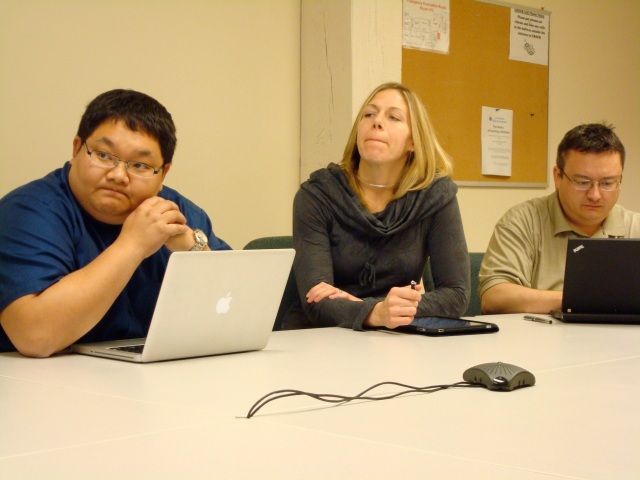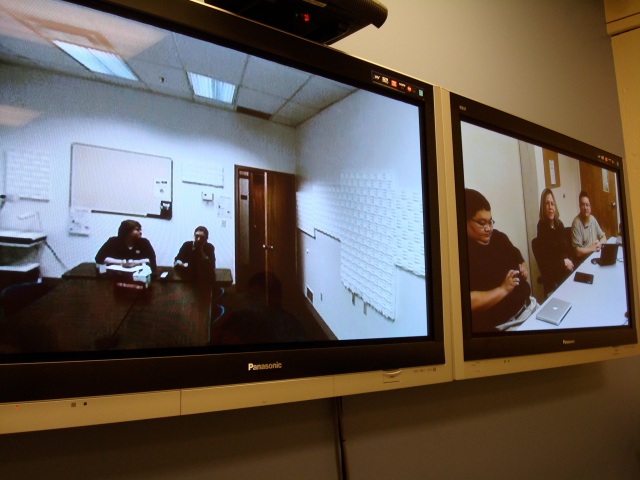Is that too bold a headline? Well, our visiting distance education professionals are from Alaska. And Maine and Alaska are on opposite sides of North America. And UMaine Augusta and University of Alaska Fairbanks (UAF) are collaborating on improving distance education in both places. It makes sense that Maine would form this distance learning partnership with the state that is as distant as you can go without crossing an ocean!
Earlier this week I was part of a group of UMA distance learning students who met with the Alaskans at URock. The other students were Kristin Belyea, Ashley Bickford, Sue Goff, and Evan Grant. The Alaskan folks were Christen Bouffard, Alex Hwu, and Chris Lott, all instructional designers at the Center for Distance Education (CDE) program at UAF. That means they design the courses for distance learning. Rounding out the group was Deborah Meehan, who is the Director of URock, and Curt Madison, the new Director of Distance Education for the University of Maine system (and the former head of distance education at University of Alaska).

Alex, Christen, and Chris - part of the instructional design team at the Center for Distance Education at University of Alaska Fairbanks
Why Alaska and Maine? Well, we are similar in that we both have rural populations far from university campuses. Apparently the Alaskans have created amazing course content and curricula but have administrative challenges in getting the word out to rural students. UMA is adept at outreach to outlying populations but have challenges in designing content for courses. With this partnership, we can learn from each other and fill each other’s gaps.
At the first session, we students talked about what works and what doesn’t work for us with the various distance delivery methods: online, ITV, video-conference, live courses (which are still considered distance education since we take them at the URock center instead of the UMA campus) and hybrid courses. And let me just say, we are all very different in our preferences. I love online classes and Sue has never taken one. Evan’s least favorite format is ITV with class capture (recorded for later viewing) while Kristin, a single mom, likes it very much for the convenience. Sue prefers live classes because she values the face-to-face interaction with the instructor.
And that speaks to one of the aims of the CDE instruction designers: get rid of the disconnection of distance learning and enhance the teacher-learner relationship. One thing that Alex said that really sticks with me is how they work with teachers to build a course. Basically they say, “Wipe out all you know about face-to-face teaching. What would you want? What would you do?” What this tells me is that they aren’t trying to make a face-to-face course fit into the perceived confines of an online format. Instead they are using all that the Web and the technology and the instructor have to offer to create a truly interactive learning experience.
The second session opened up the discussion to UMA sites all over Maine via video-conference. What I came away with is…wow! Chris talked about their process and philosophy as they develop courses. A designer works with faculty individually, and for a 3-credit course, it takes about 100 hours for the instructor and 120-200 hours for the course designer (!). It’s stunning to think of the work that goes on backstage before students ever even log on to Blackboard! They talked about “augmented realities” and “virtual worlds” – things you simply can’t do in a face-to-face class.
How about an astronomy class where students can actually access the Smiley telescope at the Pisgah Astronomical Research Institute? The Alaskans are doing it.
How about data sets overlaid on an existing world visual using a smart phone? I’m not even sure what that means, but it’s exciting that this is just one possibility of using technology to enhance learning.
Another exciting idea, and a boon for students who are tired of pricey textbooks: an open resource class. This was an Art, Drama, and Music class that incorporated free web sources instead of a textbook. The designers embedded voice lectures from the teacher, so, for example, you’re looking at the painting while you hear your teacher talk about it. What a great way to experience online learning! In fact, it sounds almost like a field trip to a museum. Students create blogs to reflect on the their assignments and share their experiences, and some students continue to maintain their blogs after the class is over. I’ve checked out a few of them, and they’re thoughtfully written and gorgeous to look at. So different from a test or essay!
If this is the future of distance learning, like I said…wow!




Pingback: The more things change, the more they change | Going the Distance…Three Credits at a Time
Pingback: $20 Million for Online Classes! | Going the Distance…Three Credits at a Time